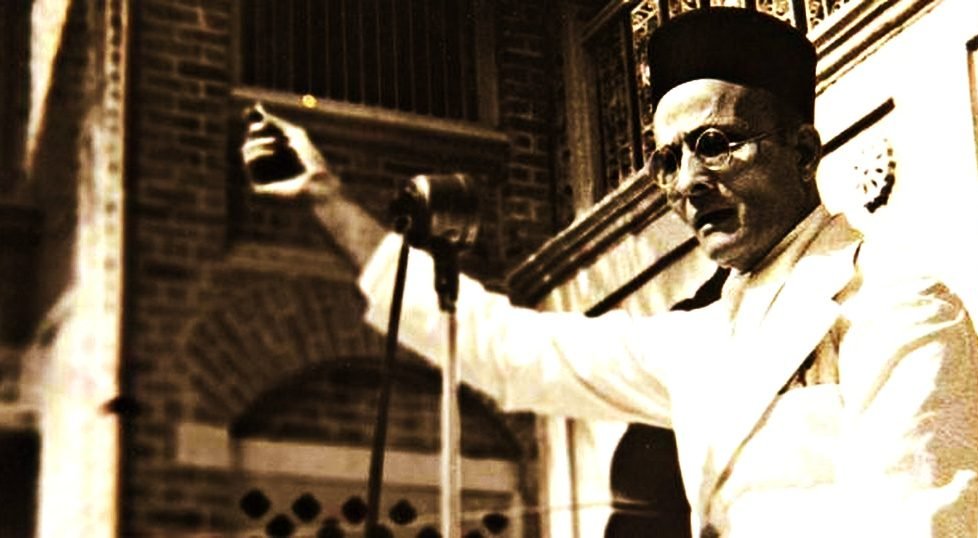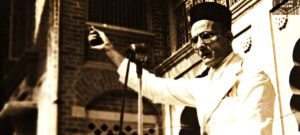Veer Vinayak Damodar Savarkar: A true son of Bhārat Mātā, “the man who sacrificed and suffered”.


Bharatbhoomi has been the land of warriors, saints and revolutionaries who fought for the freedom of Bharat Mata from foreign yoke, be it Islamic invaders like the Mughals or Christian Imperialists like the British. One such son of soil is Vinayak (fondly called Tatya) Damodar Savarkar.
Veer Savarkar was born to Shrimati Radha and Shri Damodar Savarkar on 28th May 1883 in Nashik District’s Bhagur. He was a bright student who was an avid reader and adept at writing poetry from a very young age. He was an historian par excellence who produced several historical studies. He was also a polyglot (one who knows many languages ) with proficiency in Marathi, Sanskrit, Hindi, English, Urdu, Punjabi and Bengali.
While Alive or Dead, the aura of Veer Savarkar has caused heartburn and jealousy to every self-proclaimed pseudo nationalist and communist. A generation of government sponsored fake historians, sold intellectuals and self-hating propagandist adulterated complete two generations by parroting insidious and fake stories on Veer Savarkar.
Veer Savarkar was a proponent of armed resistance against British colonial rule. He founded the Abhinav Bharat Society in 1904, which aimed to overthrow British rule through armed revolution and unite Indians abroad. The society played a crucial role in mobilizing Indian students and intellectuals living in England. Savarkar’s involvement in the Swadeshi movement, the India House in London, and his writings inspired a generation of freedom fighters. Three leaflets were printed in India House:-
1) Gurumukhi leaflet – This appealed to the Sikhs to revolt against the British. 2) ‘Oh Martyrs!’ – This was addressed to the fighters of the 1857 war. Savarkar assured them ‘ your blood oh martyrs, shall be avenged. We will continue your fight and drive the British out of India. 3) ‘Choose, oh Indian Princes’- This was sent out to Indian Princes, Rajas and Maharajas after Dhingra’s martyrdom in August 1909. Veer Savarkar appealed to them to join in the freedom struggle.
Veer Savarkar opposed the division of the sacred Bharatbhoomi & any negotiations with Muslim League. Veer Savarkar Copy of the telegram sent to Dr. Mookerji and Dr. Moonje by Bar. V. D. Savarkar the. president of the Hindu Mahasabha on the 3rd of Sept., 1942: — “I as the president issue this instruction. That president moslem league must not be re interviewed or negotiated with on behalf of the Hindu Mahasabha unless he invites stop letter follows.
Savarkar was not an armchair reformer. His activities in the social sphere were no less revolutionary than his exploits in armed struggle. “The problem of untouchability has ceased to be merely a social question. It now threatens the very integrity of our Hindusthan. It now promises to be an important political calamity.” (1947, Akhand Hindusthan ladha parva or phase of the battle for Akhand Hindusthan, p. 370). “He who wants to truly serve the nation should champion that which is in the interests of the people irrespective of whether it is popular or not. He who upholds or rejects a principle or policy that is in national interest solely with an eye on whether he will be applauded or humiliated is not a sincere servant of the people.” (1937, Balarao Savarkar, Hindu Samaj Sanrakshak parva, Veer Savarkar Prakashan, Mumbai, 1972, p. 159). Savarkar self-composed axiom in this respect was “Varam janahitam dhyeyam kevalaa na janastutihi!” (“Not praise of people, public welfare alone!”). Veer Savarkar proposed close socio-cultural bond of sons of Maa Bharati as according to him it was only the binding force which could bind millions of people of different social groups. He built PatitPavan Mandir in the Ratnagiri district to allow entry to all Hindus.
Veer Savarkar spent 11 long precious years in solitary confinement at Andaman. He underwent the severest of cruelty, physical torture and horrible suffering that no mortal humanity could have withstood. Veer Savarkar was kept in solitary confinement overlooking a gallows room where freedom fighters were hanged daily. Veer Savarkar was manacled, made to eat rice riddled with worms. A rubber catheter used to be inserted through the nostril through to the gullet into the stomach for force feeding. Many never survived this torture. No medical relief was available. Along with fellow prisoners in groups, he was chained like bullocks, blindfolded and dragged to the oil mills. Flogging at intermittent hours was normal practice. Shameless intellectuals, historians and the then leaders never acknowledged such sacrifice. Never uttered or condemned British Raj just out of fear and favor. The world never heard of such mass torture. The venomous elite historians and so-called intellectuals of the coming generations kept the secret from the new generation in order to manipulate and pollute their minds. Numerous False hood and trivial ridicule had been spread by Fake Historians about Veer Savarkar. Multiple petitions for relief from Kalapani makes headlines even these days to belittle the sacrifice of Veer Savarkar especially by Communist historians. These were the same group of British agents who stood behind the Raj, conspired to balkanize India, Supported appeasement policy and supported China in 1962. What Veer Savarkar did was a simple legal exercise for remission available under the rules in those days.
Savarkar’s nationalist ideology emphasized the concept of Hindutva, which can be loosely translated as “Hinduness” or “Hindu identity.” He argued that India should be a Hindu nation, reflecting the majority population and its cultural heritage. According to Savarkar, Hindu nationalism was not limited to religious practices but encompassed a broader civilizational and cultural identity. He dedicated himself to the cause of ‘uniting Hindus’ as he was of the opinion that Congress was sacrificing Hindu interests for minority support. He began the Shuddhi Movement to re-convert ex-Hindus and rehabilitate them. Both the Congress and several Muslim leaders were unhappy with the Shuddhi movement. In his interaction with Muslim leader Shaukat Ali, Savarkar said “if Muslims are allowed to organize and convert Hindus then Hindus should have the same rights”. In his novel Mala kai Tyache (The Revolt of Moplahs) he highlighted the atrocities suffered by Hindus in Kerala which was ignored by the Congress leaders and dismissed as class struggle by Marxists. Savarkar was of the view that it was largely a religious attack on Hindus and a sign of things to come. How visionary!!
The three qualities of Hindus as defined by Savarkar were anyone who considers Bharat as their fatherland, shares a common bond of blood/race and Bharat is their holy land (Punyabhoomi). His definition of Hindutva included all religions that originated in Bharat such as Jainism, Buddhism, Sikhism and all variants of Vedic traditions and at the same time it excludes all religions whose holy lands are outside Bharat i.e. Christianity, Islam and Judaism.
While there has always been an attempt to undermine Veer Savarkar’s contribution in the freedom movement, the father of the nation, ‘Mahatma Gandhi’ himself used to address him as BHAI and he wrote an article in Young India on 26 May, 1920 arguimg for the release of his brothers addressing their work in Swadeshi movement as prominent. Former Prime Minister Indira Gandhi mentioned him as the remarkable son of India.
As India progresses in the 21st century, the celebration of Savarkar Jayanti serves as a reminder of the diversity of India’s freedom struggle and the various perspectives that shaped the nation’s path to independence. Bharat is a billion strong now and every son of Maa Bharati reveres Veer Savarkar, while there is a minute group of despondent people who are doomed to disappear under the bright figure of Veer Savarkar.
 ‘Our Motherland, Sacrifice for you is like Life, Living without you is Death.’ – Veer Savarkar
‘Our Motherland, Sacrifice for you is like Life, Living without you is Death.’ – Veer Savarkar
DISCLAIMER: The author is solely responsible for the views expressed in this article. The author carries the responsibility for citing and/or licensing of images utilized within the text.
